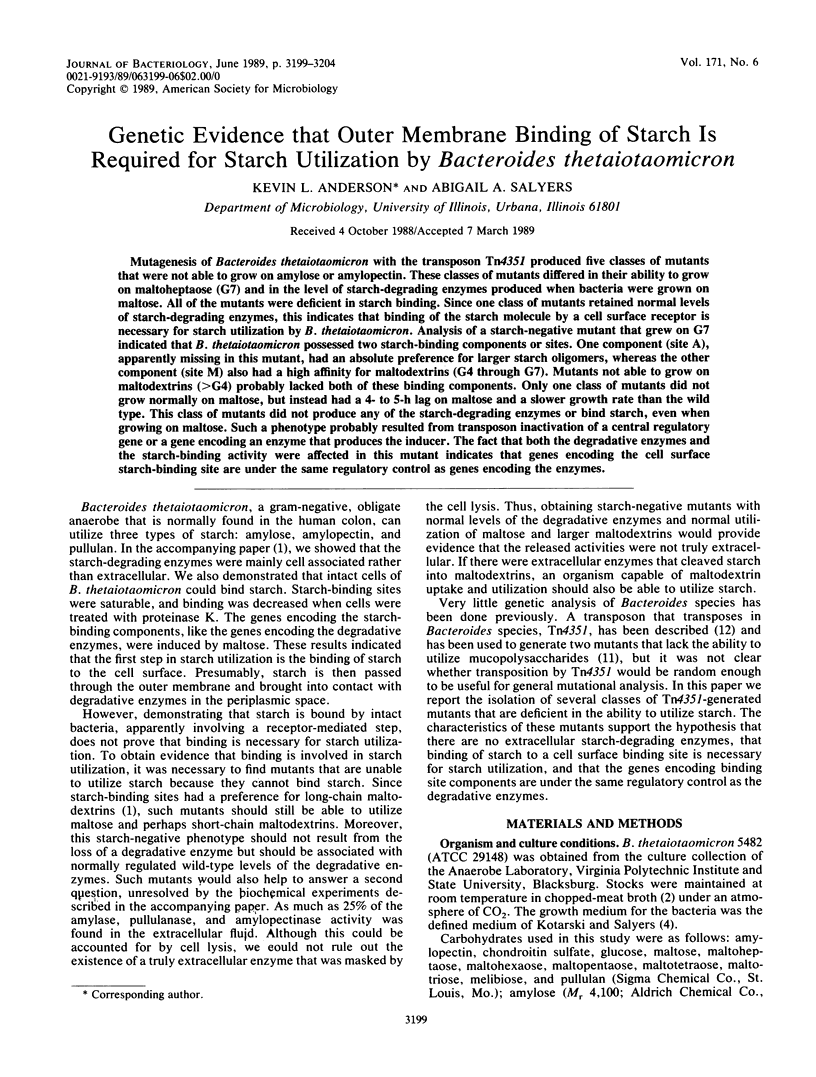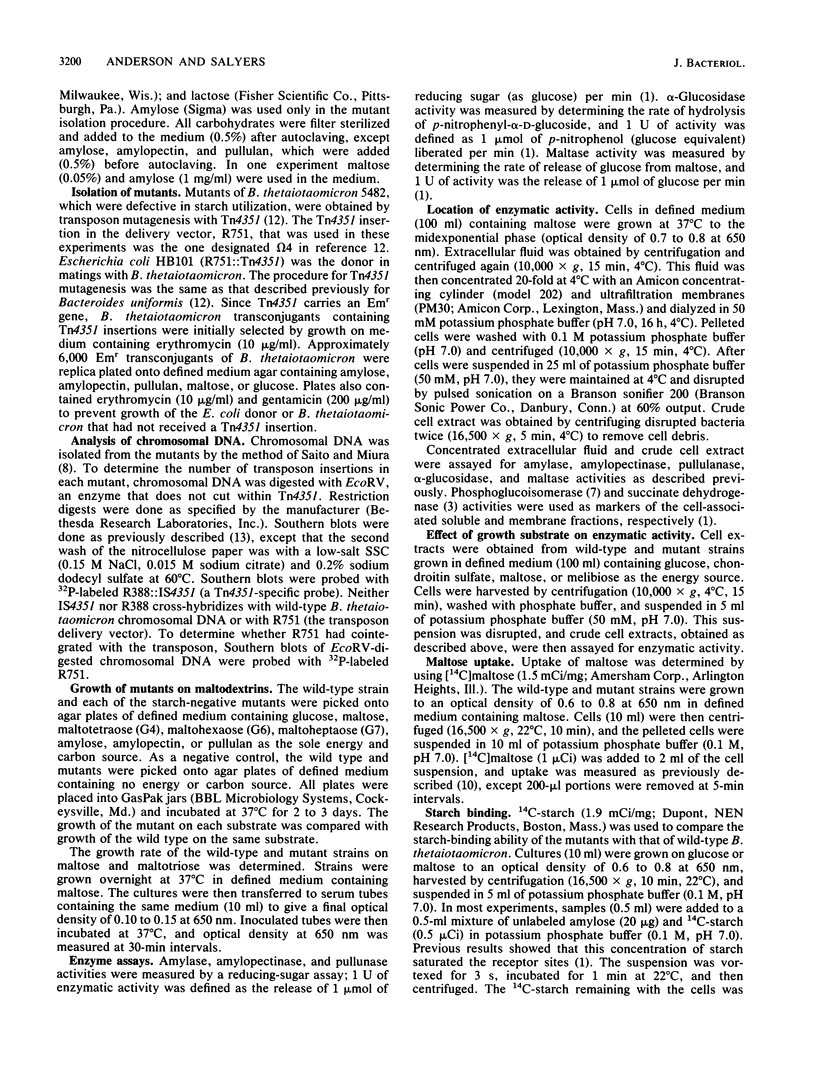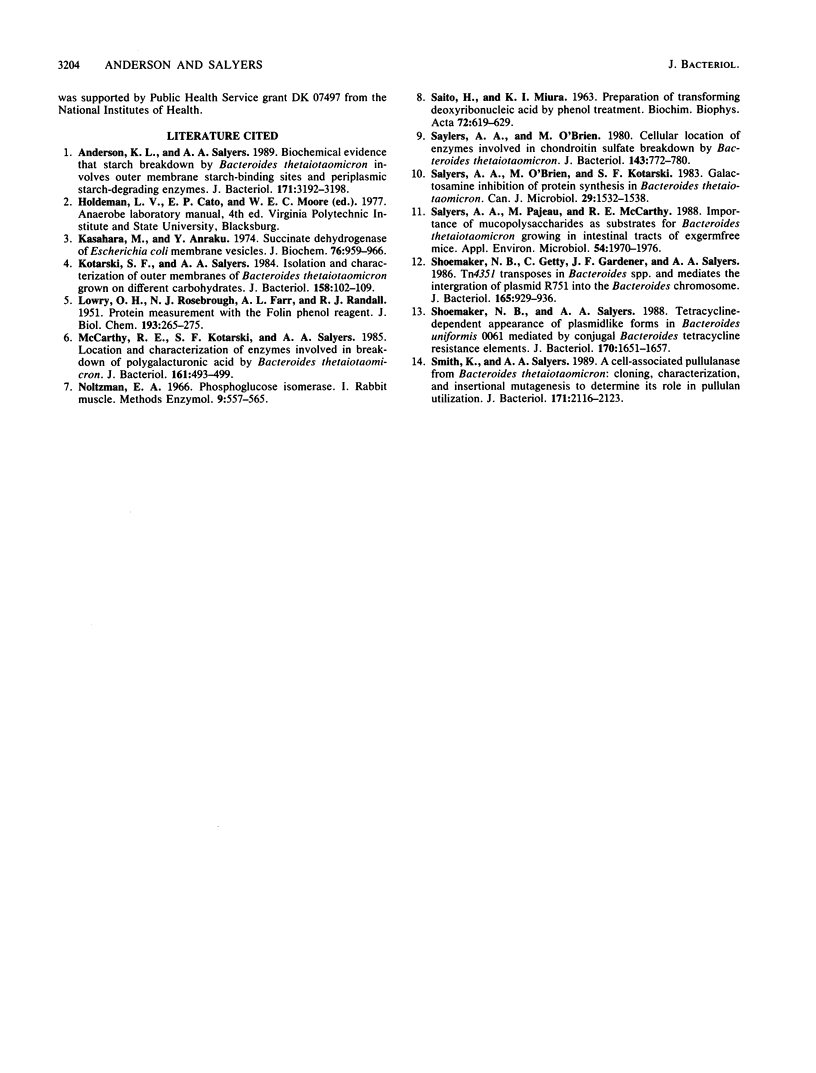Abstract
Mutagenesis of Bacteroides thetaiotaomicron with the transposon Tn4351 produced five classes of mutants that were not able to grow on amylose or amylopectin. These classes of mutants differed in their ability to grow on maltoheptaose (G7) and in the level of starch-degrading enzymes produced when bacteria were grown on maltose. All of the mutants were deficient in starch binding. Since one class of mutants retained normal levels of starch-degrading enzymes, this indicates that binding of the starch molecule by a cell surface receptor is necessary for starch utilization by B. thetaiotaomicron. Analysis of a starch-negative mutant that grew on G7 indicated that B. thetaiotaomicron possessed two starch-binding components or sites. One component (site A), apparently missing in this mutant, had an absolute preference for larger starch oligomers, whereas the other component (site M) also had a high affinity for maltodextrins (G4 through G7). Mutants not able to grow on maltodextrins (greater than G4) probably lacked both of these binding components. Only one class of mutants did not grow normally on maltose, but instead had a 4- to 5-h lag on maltose and a slower growth rate than the wild type. This class of mutants did not produce any of the starch-degrading enzymes or bind starch, even when growing on maltose. Such a phenotype probably resulted from transposon inactivation of a central regulatory gene or a gene encoding an enzyme that produces the inducer. The fact that both the degradative enzymes and the starch-binding activity were affected in this mutant indicates that genes encoding the cell surface starch-binding site are under the same regulatory control as genes encoding the enzymes.
Full text
PDF





Images in this article
Selected References
These references are in PubMed. This may not be the complete list of references from this article.
- Anderson K. L., Salyers A. A. Biochemical evidence that starch breakdown by Bacteroides thetaiotaomicron involves outer membrane starch-binding sites and periplasmic starch-degrading enzymes. J Bacteriol. 1989 Jun;171(6):3192–3198. doi: 10.1128/jb.171.6.3192-3198.1989. [DOI] [PMC free article] [PubMed] [Google Scholar]
- Kasahara M., Anraku Y. Succinate dehydrogenase of Escherichia coli membrane vesicles. Activation and properties of the enzyme. J Biochem. 1974 Nov;76(5):959–966. [PubMed] [Google Scholar]
- Kotarski S. F., Salyers A. A. Isolation and characterization of outer membranes of Bacteroides thetaiotaomicron grown on different carbohydrates. J Bacteriol. 1984 Apr;158(1):102–109. doi: 10.1128/jb.158.1.102-109.1984. [DOI] [PMC free article] [PubMed] [Google Scholar]
- LOWRY O. H., ROSEBROUGH N. J., FARR A. L., RANDALL R. J. Protein measurement with the Folin phenol reagent. J Biol Chem. 1951 Nov;193(1):265–275. [PubMed] [Google Scholar]
- McCarthy R. E., Kotarski S. F., Salyers A. A. Location and characteristics of enzymes involved in the breakdown of polygalacturonic acid by Bacteroides thetaiotaomicron. J Bacteriol. 1985 Feb;161(2):493–499. doi: 10.1128/jb.161.2.493-499.1985. [DOI] [PMC free article] [PubMed] [Google Scholar]
- SAITO H., MIURA K. I. PREPARATION OF TRANSFORMING DEOXYRIBONUCLEIC ACID BY PHENOL TREATMENT. Biochim Biophys Acta. 1963 Aug 20;72:619–629. [PubMed] [Google Scholar]
- Salyers A. A., O'Brien M. Cellular location of enzymes involved in chondroitin sulfate breakdown by Bacteroides thetaiotaomicron. J Bacteriol. 1980 Aug;143(2):772–780. doi: 10.1128/jb.143.2.772-780.1980. [DOI] [PMC free article] [PubMed] [Google Scholar]
- Salyers A. A., O'Brien M., Kotarski S. F. Galactosamine inhibition of protein synthesis in Bacteroides thetaiotaomicron. Can J Microbiol. 1983 Nov;29(11):1532–1538. doi: 10.1139/m83-235. [DOI] [PubMed] [Google Scholar]
- Salyers A. A., Pajeau M., McCarthy R. E. Importance of mucopolysaccharides as substrates for Bacteroides thetaiotaomicron growing in intestinal tracts of exgermfree mice. Appl Environ Microbiol. 1988 Aug;54(8):1970–1976. doi: 10.1128/aem.54.8.1970-1976.1988. [DOI] [PMC free article] [PubMed] [Google Scholar]
- Shoemaker N. B., Getty C., Gardner J. F., Salyers A. A. Tn4351 transposes in Bacteroides spp. and mediates the integration of plasmid R751 into the Bacteroides chromosome. J Bacteriol. 1986 Mar;165(3):929–936. doi: 10.1128/jb.165.3.929-936.1986. [DOI] [PMC free article] [PubMed] [Google Scholar]
- Shoemaker N. B., Salyers A. A. Tetracycline-dependent appearance of plasmidlike forms in Bacteroides uniformis 0061 mediated by conjugal Bacteroides tetracycline resistance elements. J Bacteriol. 1988 Apr;170(4):1651–1657. doi: 10.1128/jb.170.4.1651-1657.1988. [DOI] [PMC free article] [PubMed] [Google Scholar]
- Smith K. A., Salyers A. A. Cell-associated pullulanase from Bacteroides thetaiotaomicron: cloning, characterization, and insertional mutagenesis to determine role in pullulan utilization. J Bacteriol. 1989 Apr;171(4):2116–2123. doi: 10.1128/jb.171.4.2116-2123.1989. [DOI] [PMC free article] [PubMed] [Google Scholar]



